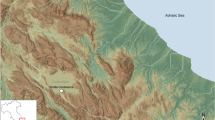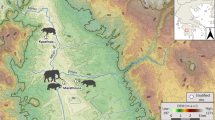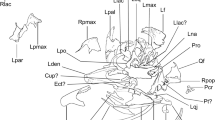Abstract
Los CERRITOS, a late Chorrera (Engoroy) cemetery on the Santa Elena Peninsula of Ecuador yielded artefacts and radiocarbon assay which indicate that use of the site began about 840 BC and continued for several years within the Late Formative1. The human skulls from the site are of particular interest because many showed heavy accumulations of supragingival dental calculus (tartar), which contrast with the relatively slight calculus accumulations on the teeth of skulls recovered from the earlier Valdivia (3000–1500 BC) site of Real Alto2, also on the Santa Elena Peninsula. We argue here that the heavy calculus accumulations are the result of habitual, secular coca chewing in late Chorrera times. This diagnosis, in turn, supports the hypothesis of prehistoric trade in coca, probably in exchange for mollusc shells, with inhabitants of the eastern Andean slopes.
This is a preview of subscription content, access via your institution
Access options
Subscribe to this journal
Receive 51 print issues and online access
$199.00 per year
only $3.90 per issue
Buy this article
- Purchase on Springer Link
- Instant access to full article PDF
Prices may be subject to local taxes which are calculated during checkout
Similar content being viewed by others
References
Zevallos, M. C. Revista del Museo National, Lima, Peru 34, 20–27 (1965–66).
Lathrap, D. W. & Marcos, J. G. Revista de la Universidad Catolica, Pontificia Universidad Catolica del Ecuador, Quito. Numero Monografico: Arqueologia Ano III, no. 10, 41–64 (1975).
Cooper, J. M. in Handbook of South American Indians (ed. Steward, J. H.), 525 (Smithsonian Institution, Bureau of American Ethnology, Bulletin 143, Washington, DC, 1949).
Mortimer, W. G. Peru. History of Coca: The Divine Plant of the Incas (Vail, New York, 1901).
Towle, M. The Ethnobotany of Peru (Wenner-Gren Foundation, New York, 1961).
Mehta, F. S., Sanjara, M. K., Bareto, M. A. & Doctor, R. J. Am. dent. Ass. 50, 531–536 (1955).
Leigh, R. W. Mem. Bernice P. Bishop Mus. 11, 255–273 (1930).
Leigh, R. W. Am. J. Phys. Anthrop. 22, 267–296 (1937).
Moodie, R. L. Pacif. Dent. Gaz. 39, 24–29 (1931).
Rose, H. J., Alder, I. & Flanagan, F. J. U.S. Geol. Surv. Prof. Pap. 450-B, 80–85 (1962).
Mukherjee, S. J. periodont. Res. Suppl. 2, 1–35 (1968).
Glickman, I. Clinical Periodontology, 4th edn (Saunders, Philadelphia, 1972).
Schroeder, H. E. Formation and Inhibition of Dental Calculus (Huber, Berne, 1969).
Hodge, H. C. & Leung, S. W. J. Periodont. 21, 211–221 (1950).
Lathrap, D. W., Collier, D. & Chandra, H. Ancient Ecuador: Culture, Clay and Creativity 3000–300 B.C (Field Museum of Natural History, Chicago, 1975).
Myers, T. P. Am. Antiq. 41, 353–360 (1976).
Lathrap, D. W. World Archaeol. 5, 170–186 (1973).
Paulsen, A. C. Am. Antiq. 39, 597–607 (1974).
Author information
Authors and Affiliations
Rights and permissions
About this article
Cite this article
KLEPINGER, L., KUHN, J. & THOMAS, J. Prehistoric dental calculus gives evidence for coca in early coastal Ecuador. Nature 269, 506–507 (1977). https://doi.org/10.1038/269506a0
Received:
Accepted:
Published:
Issue Date:
DOI: https://doi.org/10.1038/269506a0
Comments
By submitting a comment you agree to abide by our Terms and Community Guidelines. If you find something abusive or that does not comply with our terms or guidelines please flag it as inappropriate.



